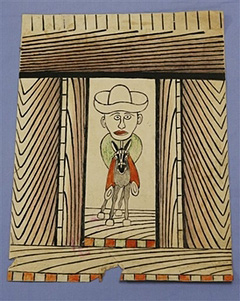 |
 |
 |
 Vallarta Living | Art Talk | October 2007 Vallarta Living | Art Talk | October 2007  
Newly Discovered Works by Mexican Artist
 Ula Ilnytzky - Associated Press Ula Ilnytzky - Associated Press
go to original


| | A drawing by the late Mexican artist Martin Ramirez is photographed Monday, Oct. 29, 2007 in New York. Some 140 drawings by Ramirez, once earmarked for the trash, have survived for more than two decades in a garage. Now a selection of those works will be exhibited at the Folk Art Museum in New York next year. (AP/Mary Altaffer) |
New York — Some 140 drawings by the late Mexican folk artist Martin Ramirez, once destined for the trash, survived for more than two decades in a California garage and will be shown next year at the American Folk Art Museum.

The discovery of the works by the self-taught draftsman, who spent almost three decades in mental institutions, was astounding given that only 300 of his drawings and collages were known to exist until now, the museum said Monday.

The 144 works, drawn in the last three years of the artist's life and in excellent condition, were stored in boxes atop a refrigerator in the Sacramento area garage of a woman whose father-in-law was medical director at a state hospital where Ramirez was a patient.

"Although I always thought there would be a work or two or three found in attics or basements of nurses, doctors and janitors, it's beyond my imagination that we would find over 100 works," said curator Brooke Davis Anderson. "This is more than significant."

Ramirez composed in a figurative style with detailed, symmetrical motifs that fused his recollections of growing up in Mexico's rural Jalisco state, his migrant worker years in California and his subsequent hospitalization after a mental breakdown.

His drawings command tens of thousands of dollars on the art market.

Earlier this year, the museum mounted a well-received retrospective of 96 of Ramirez's works. Some of the newly discovered work will be displayed next October, Anderson said.

Peggy Dunievitz, 73, called the museum after reading an article about the retrospective. Her father-in-law, Dr. Max Dunievitz, was medical director at DeWitt State Hospital in Auburn, Calif., where Ramirez died in 1963 at age 68. Until reading the article, she had been unaware of the significance of Ramirez's works, she told The New York Times, which first reported the story in Monday editions.

The family has donated three of the works to the museum; the remainder will be sold and the money will be donated in honor of Ramirez's family to a foundation to preserve Mexican heritage. Ramirez's heirs have never owned one of his drawings.

Socorro Alonso, 29, a great-granddaughter of Ramirez, said the family was "overwhelmed" with the discovery, and happy to know "that there's more for everyone to see."

Dunievitz's son, Phil, told the Times the drawings had been set aside to be thrown out after Max Dunievitz died in 1988, but that he rolled them up and put them in the garage because he remembered seeing them in his grandfather's house.

Some of the drawings will be displayed in December at New York's Ricco Maresca Gallery, which is representing the works for the Dunievitz family.

Gallery owner Frank Maresca said the newly discovered works demonstrate how the artist's style had matured by the end of his life.

The drawings explore some of the same motifs and themes found in his earlier works but "show a very distinct stylistic change and abstraction that wasn't there," he said. | 
 | |
 |



